Shown below is a snippet of code where I try and reference my ApplicationProperties bean. When I reference it from the constructor it is null, but when referenced from another method it is fine. Up until now I have not had no problem using this autowired bean in other classes. But this is the first time I have tried to use it in the constructor of another class.
In the code snippet below applicationProperties is null when called from the constructor but when referenced in the convert method it is not. What am I missing
@Component
public class DocumentManager implements IDocumentManager {
private Log logger = LogFactory.getLog(this.getClass());
private OfficeManager officeManager = null;
private ConverterService converterService = null;
@Autowired
private IApplicationProperties applicationProperties;
// If I try and use the Autowired applicationProperties bean in the constructor
// it is null ?
public DocumentManager() {
startOOServer();
}
private void startOOServer() {
if (applicationProperties != null) {
if (applicationProperties.getStartOOServer()) {
try {
if (this.officeManager == null) {
this.officeManager = new DefaultOfficeManagerConfiguration()
.buildOfficeManager();
this.officeManager.start();
this.converterService = new ConverterService(this.officeManager);
}
} catch (Throwable e){
logger.error(e);
}
}
}
}
public byte[] convert(byte[] inputData, String sourceExtension, String targetExtension) {
byte[] result = null;
startOOServer();
...
Below is s snippet from ApplicationProperties ...
@Component
public class ApplicationProperties implements IApplicationProperties {
/* Use the appProperties bean defined in WEB-INF/applicationContext.xml
* which in turn uses resources/server.properties
*/
@Resource(name="appProperties")
private Properties appProperties;
public Boolean getStartOOServer() {
String val = appProperties.getProperty("startOOServer", "false");
if( val == null ) return false;
val = val.trim();
return val.equalsIgnoreCase("true") || val.equalsIgnoreCase("on") || val.equalsIgnoreCase("yes");
}
